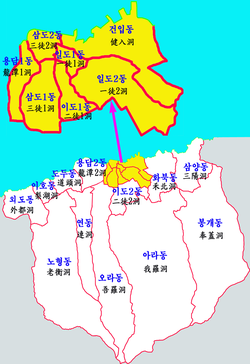| Geonip | |
|---|---|
| Dong | |
| Korean transcription(s) | |
| • Hangul | 건입동 |
| • Hanja | 健入洞 |
 | |
 | |
| Coordinates: 33°25′55.13″N 126°23′19.54″E / 33.4319806°N 126.3887611°E / 33.4319806; 126.3887611 | |
| Country | South Korea |
| Area | |
| • Total | 2.53 km (0.98 sq mi) |
| Population | |
| • Total | 8,866 |
| • Density | 3,500/km (9,100/sq mi) |
| Dialect | Jeju |
Geonipdong is a neighbourhood in Jeju City, South Korea.
Etymology
The origin of the name is unclear, but there are various theories. One source dates it back to Silla, saying the name geonip was created as a reference to the members of the Go family of Jeju entering Jeju from Silla.
History
Geonip first started as Geonip district in 1914. Geonip-dong was incorporated into Jeju City in 1955 and became a dong.The neighborhood originally started as a fishing town, but was commercialized asa result of opening of the nearby Port of Jeju
Geography
Geonip-dong is commonly referred to as a mountainous area because it is a village centered on the Sanjicheon in the west, and it is a rare example of several neighborhoods centered on 'Goeunimor(고으니모르)', which is the border point with Hwabuk, to the east, forming a single natural village and forming a legal-status neighborhood. It is divided into 20 Tongs and 113 bans.
Attractions
The neighborhood hosts the museum of Gim Man-deok(built in 1978), the Sarabong mountain and the Mochungsa shrine. It also has the Jeju National Museum. In 2023,the April 3rd incident history museum opened in the town's old alcohol factory site that was formerly used as a concentration camp for the victims.
References
- ^ "일반현황".
- ^ "설촌유래".
- ^ "건입동". jejusi.gov.kr.
- "Kim Man-deok, remarkable female philanthropist". April 30, 2018. Retrieved June 2, 2022.
- "제주4.3 주정공장 옛터, 치유.역사교육 공간으로 재탄생".